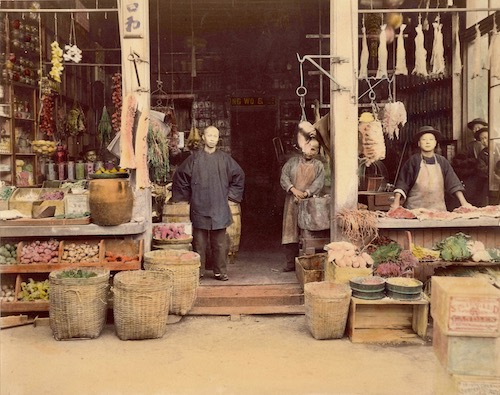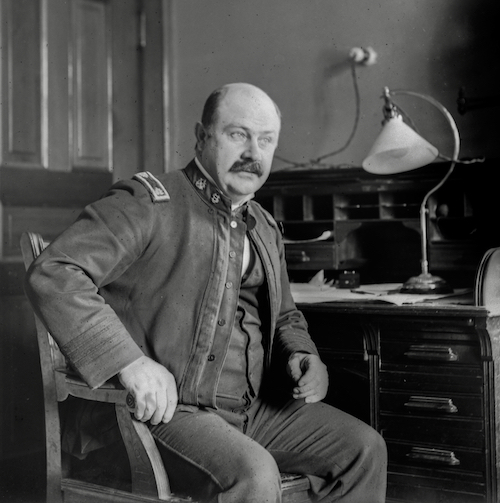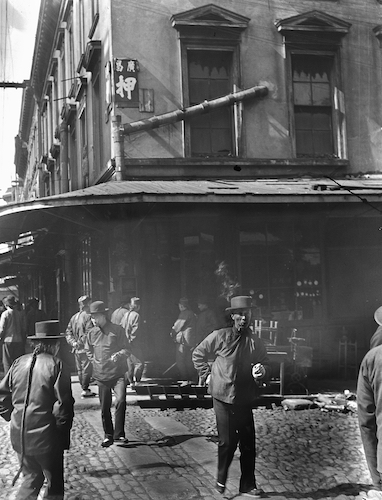Communiqué
Discover how bubonic plague in 1900 set off fear in “Plague at the Golden Gate” on AMERICAN EXPERIENCE, May 24 at 9 pm
< < Back toAmerican Experience Plague at the Golden Gate
Premieres Tuesday, May 24, 2022 on PBS
The Gripping Story of the Race Against Time to Save San Francisco and the Nation from Bubonic Plague
Over 100 years before the COVID-19 pandemic shut down the world and set off a wave of fear and anti-Asian sentiment, an outbreak of bubonic plague in San Francisco’s Chinatown in 1900 unleashed a similar furor. It was the first time in history that civilization’s most feared disease — the infamous Black Death — made it to North America. Two doctors — vastly different in temperament, training and experience — used different methods to lead the seemingly impossible battle to contain the disease before it could engulf the country. In addition to overwhelming medical challenges, they faced unexpected opposition from business leaders, politicians, and even the president of the United States. Fueling the resistance would be a potent blend of political expediency, ignorance, greed, racism, and deep-rooted distrust of not only federal authority but science itself. Scapegoated as the source of the disease early on, the Chinese community fought back against unjust, discriminatory treatment. The gripping story of the desperate race against time to save San Francisco and the nation from the deadly disease, Plague at the Golden Gate is based in part on David K. Randall’s critically acclaimed book, Black Death at the Golden Gate. Directed by Li-Shin Yu and executive produced by Cameo George, the film premieres Tuesday, May 24, 2022, 9:00-11:00 p.m. ET on American Experience on PBS, PBS.org and the PBS Video App.

© Burk Uzzle/KEYSTONE Pictures/ZUMAPRESS.com/Alamy Live News
“Though this episode took place more than 100 years ago, this story of stopping an unknown, deadly disease and the misplaced fear that was generated as part of that is all too familiar to us right now,” said American Experience executive producer Cameo George. “A cautionary tale of the harm that scapegoating a community can cause, Plague at the Golden Gate is also a reminder that well-applied scientific reasoning and innovation can be the best solutions to societal issues.”
At the turn of the 20th century, San Francisco aspired to be the “Paris of the West.” A former Gold Rush boomtown, it was now an international trading hub flush with new money and business empires. The steamship era enabled the swift global transport of not only goods and people — but also diseases. The death of immigrant Wong Chut King in Chinatown might have gone unnoticed if not for Dr. Joseph Kinyoun, a scientist with the Marine Hospital Service and a star in the fledgling field of microbiology. Kinyoun, acutely aware of the plague epidemic ravaging the Pacific Rim, also knew that San Francisco — America’s Far East portal — was particularly vulnerable. After multiple tests, he confirmed that Wong’s death was from bubonic plague, the first case ever diagnosed in the U.S.
To stop the spread, Kinyoun resorted to the accepted measures of the day, which were based on rudimentary scientific knowledge and shaped by commonly-held racist beliefs. He targeted the already marginalized Chinese population, imposing quarantines, forced searches, fumigation, incineration — even ordering mandatory vaccinations and travel bans for anyone of Asian descent. But the Chinese community fought back, bringing class-action lawsuits for violating their rights; the judge ruled in favor of the Chinese. Kinyoun’s continued efforts were met with increasing resistance and derided in the press, while legislators lobbied for his transfer. Even California Governor Henry Gage accused Kinyoun and federal doctors of creating a fake plague, injecting corpses with secretly-imported bacteria.

As the plague spread, local and state politicians, health officials, union leaders and business leaders fought. Who had authority? How could the city’s economy be saved from threats of boycotts? Was the disease even real? And what could be done about “the Chinese problem,” since many falsely believed that only “rice eaters” could get sick?
When the press exposed a private deal made between Governor Gage, Surgeon General Wyman and President McKinley to keep the plague secret, the blame fell on Kinyoun. He was unceremoniously relocated to Detroit.
Wyman replaced Kinyoun with Dr. Rupert Lee Blue, a 32-year-old physician who, unlike his predecessor, was not a research scientist. Although the job came with seemingly insurmountable obstacles, it was a high-profile chance for Blue to prove himself.
Hoping to build relationships with the Chinese community, Blue set up a lab on Chinatown’s Merchant Street, walking into shops and talking to residents. He relied upon the services of translator Wong Chung, who helped Blue understand why the Chinese community resisted Western medical interventions. Since Chinese bodies tended to disappear after death to prevent autopsies, Blue created his own morgue service to find and inspect bodies quickly.
Revising Kinyoun’s harsh protocols, Blue disinfected only specific houses, not entire neighborhoods, and quarantined immediate family members for the shortest time possible. On September 11, 1901, following a tip from Wong Chung, Blue and his men found a living patient with the plague, someone from whom they hoped to gain insight into the disease. But there was still no breakthrough in eradicating the disease or understanding its modes of transmission.
After dissecting dead rats and finding they contained plague germs, Blue finally came to believe that rodents themselves could transmit the disease. If that were true, the only way to save San Francisco was to eradicate them. Working with government officials and the Chinatown business community, Blue enlisted everyone he could to help. Bounties were paid, wooden sidewalks were replaced by concrete, and old buildings torn down and rebuilt. By the spring of 1905, Chinatown was almost completely renovated.

On April 18, 1906, an earthquake struck San Francisco. Three thousand people were killed, and more than 80% of the city was destroyed. With the sewer pipes ruptured, rats ran rampant through the city. After assuming that the plague had been eradicated, in 1907 San Francisco had its first new plague death.
Blue ordered his men to kill even more rats, now armed with the knowledge that the fleas on the rodents passed the disease to humans. In 1908, the first truly grassroots, fully public, multi-sector health campaign was born. Educational efforts taught the public how to dispose of garbage properly and the city rebuilt its sanitary infrastructure. February 1908 saw the last diagnosed case of bubonic plague and San Francisco celebrated Blue as a hero.
Rupert Blue’s career continued to rise, and he eventually became the fourth Surgeon General of the United States. A forward thinker, he advocated for better treatment for the mentally ill and for national health insurance. Joseph Kinyoun brought state-of-the-art methods of diagnosing infectious diseases to America and helped found the national hygienic laboratory, the forerunner of our modern National Institutes of Health, an achievement for which he is posthumously recognized as the first director of NIH.
“Power-seeking politicians and misguided commercial greed that takes precedence over public health — all of that delayed a solution in San Francisco,” said author Marilyn Chase. “In the end, we needed collaboration and cooperation by the federal, state and local governments, participation by the citizenry, and understanding and acceptance of science.”
American Experience Plague at the Golden Gate will stream simultaneously with broadcast and be available on all station-branded PBS platforms, including PBS.org and the PBS Video app, available on iOS, Android, Roku, Apple TV, Amazon Fire TV, Android TV, Samsung Smart TV, Chromecast and VIZIO. All titles will be available for streaming with closed captioning in English, Mandarin and Spanish. PBS station members can view many series, documentaries and specials via PBS Passport. For more information about PBS Passport, visit the PBS Passport FAQ website.

